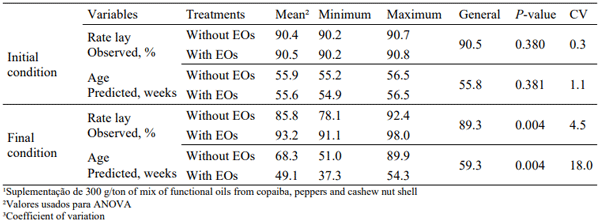I. Introduction
A consistent definition of aging was presented by DiLoreto and Murphy (2015). According to these authors, aging is the result of the non-functionality of the animal's cells, tissues and organs, caused by the stochastic degradation of its parts. This definition considers the changes that have occurred in laying hens that affect the rate of lay (Gu et al. 2021a, 2021b). The main changes are related to the digestive, reproductive system, endocrine glands and metabolic pathways (Pinto et al. 2020; Gu et al. 2021a, 2021b). The study by Gu et al. (2021a) showed that the antioxidant capacity of commercial laying hens at 75 weeks was 30% lower compared to values for hens at 28 weeks of age. On the one hand, interest in the mechanisms involved in aging has grown (DiLoreto and Murphy 2015; Gloux et al. 2019), on the other hand, there is a demand from producers to increase the period of use of commercial animals. Some information is still scarce; for example, how long can the aging of laying hens be delayed? In commercial production, this can be a tool to increase persistence of rate of lay and improve planning for placement of new flocks. Several studies have shown that supplementing diets with antioxidant molecules such as essential oils (EOs) can delay aging (Ding et al. 2017; Feng et al. 2021), maintaining or improving egg production (Jia et al. 2016; Jiang et al. 2020). These results have been confirming the effectiveness of the molecules; however, doubt remains about the extent of this effect applied to the period of use of the hens. Using the egg production curve (f), which represents the genetic potential of hens as a function of bird age (t) to interpret the response at t, using the inverse function (f-1), may assist in determining the period of use of hens. Among the models used to interpret egg production, Wood's (1967) function has been preferred, but when applied to f-1, it results in a non-trivial solution. Considering the above, the current research aimed to evaluate the effect of dietary supplementation of essential oils on the egg production of aged laying hens and, through the adjusted curve, calculate the age of the corresponding hen, using f-1 and compare whether the supplementation of essential oils delayed the aging of hens.
II. Method
The study was conducted at the Laboratory of Poultry Sciences, Faculdade de Ciências Agrárias e Veterinárias, UNESP, Campus de Jaboticabal, SP, Brazil. All procedures adopted in the research were approved by the Ethics Committee on the Use of Animals (CEUA) of Universidade Estadual Paulista, under protocol nº 1481/21. One hundred twenty-eight commercial laying hens of the Lohmann LSL-Lite lineage, 80 weeks old, were used. The design used was completely randomized with two treatments, eight replicates of eight hens each, totalling 16 experimental units. The treatments consisted of a control diet without EO supplementation and another consisting of a control diet + EO supplementation. A mix of functional oils from copaiba, peppers and cashew nut shell (Ave Pepper Phytus - Phytus Feed®) was used with inclusion of 300 g/ton. Water and feed were provided ad libitum and the lighting program was 16 hours of light. The density used was 625 cm²/bird. The experimental period was 112 days, using only the egg production averages of the last four weeks, from 92 to 96 weeks of age. To calculate the predicted age of the hens, the relationship between egg production (EP) and t was first adjusted using data from the breeder manual. Only post-peak production data, from 27 to 95 weeks of age, which describe the decline in EP as a function of the increase in t given in weeks (f) were used. The function used was: EP =λe-βt, where λ and β are estimated parameters. To calculate the value of t in weeks for some EP (%) the following equation was used: f-1: t = -ln(EP/λ)/β). The adjusted values of λ and β were 115 and 0.0043, respectively. Based on the EP values of each experimental unit, the respective t values for the beginning and end of the experiment were calculated. The values of EP and t at the beginning and end of the test were submitted to ANOVA, considering a significance of 0.05 to reject the H0.
III. Results
The results obtained from the ANOVA are shown in Table 1. As expected, the H0 for the initial condition of the EP was accepted, indicating that the treatments started under the same conditions, obtained with the standardization of the experimental units at the beginning of the trial. The predicted age of hens calculated from the EP showed the same degree of significance for accepting H0. When considered, the absolute value of the predicted age of the hens at the beginning of the trial diverged with the chronological age of the lineage manual. The chronological age of hens at the start of the assay was 80 weeks, while the prediction (t) calculated using the observed state variable EP was 55.8 weeks. After 16 weeks of trial, for hens fed diets supplemented with EOs, a significant effect was verified (P < 0.01) between treatments with EP of 92.2% and approximately 7% greater than the control diet without EO supplementation. A significant effect was verified for the predicted age variable (P < 0.01). According to the EP, hens fed with EOs showed a similar response to hens at 49.1 weeks of age, which corresponded to a 19-week difference (P < 0.01) when compared to the predicted age of hens not supplemented with EOs.
Table 1 - cumulative effect after 16 weeks under dietary treatment with essential oils of laying hens from 80 to 96 weeks of age¹
IV. Discussion
We expected that H0 would be rejected due to decreased egg production in the control group, without supplementation of EOs in the diet. In absolute values, the EP of hens supplemented with EOs increased at the end of the 16 weeks of the experiment, when we expected them only to maintain egg production. These results corroborate previous results that found that older laying hens responded positively to supplementation with nutritional additives and improved antioxidant capacity (Ding et al. 2017; Feng et al. 2021). In addition to their antioxidant function by scavenging free radicals, the EOs have an antioxidant action by inhibiting the activation pathways of nuclear factors, such as nuclear factor erythroid 2-related factor 2 (Nrf2), considered the master regulator of the cellular antioxidant response (Su et al. 2018). According to Gu et al. (2021a) the antioxidant capacity of aged commercial laying hens (75 weeks) is reduced by 30% compared with younger hens; however, the hens used in this research started the experiment at 80 weeks of age and possibly presented an even greater deficit than that reported by Gu et al. (2021a). This hypothesis may explain the 19-week difference in predicted age between treatments with and without EO supplementation. This research offers a methodological proposal to evaluate the effect of additives on the longevity of hens, which we propose here as the predicted age, using data from the lineage manual. The difference between the predicted and chronological age is based on the organic state of the hen and, in this research, it was demonstrated that the period of use of laying hens can be extended depending on the rearing conditions, especially using nutrition aim at improving the REDOX state. The supplementation of 300 g/ton of mix of functional oils in the diet of commercial laying hens improved egg production and longevity of laying hens from 80 to 96 weeks of age.
Acknowledgements
We wish to thank the Phytus Feed® for financial support of research.
Presented at the 33th Annual Australian Poultry Science Symposium 2022. For information on the next edition, click here. 











.jpg&w=3840&q=75)